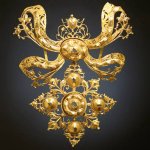We offer layaway, spread payments on the piece of your dreams. Ask us for details. Free insured shipping on all orders !!!

Antique jewelry glossary
Welcome to our extensive antique jewelry glossary with around 1,500 jewelry related entries.If you feel you are missing an explanation, feel free to let us know and we will add it.
A - B - C - D - E - F - G - H - I - J - K - L - M - N - O - P - Q - R - S - T - U - V - W - X - Y - Z all
Baroque Jewelry
(1620-1700)

See our: Baroque jewelry.
A style in art and decoration that developed shortly before 1600 and remained current in Europe until the emergence of the Rococo style c.1730. It was started in Italy, and spread to Germany, Austria, the Low Countries, and Spain and Portugal, with only a somewhat severely classical version being popular in France under Louis XIV. The style was a development of the Renaissance style and is characterized by lively, curved, and exuberant forms, by vigorous movement, and by rich ornament, based on classical sources, being symmetrical as distinguished from the asymmetry of the following Rococo style.
During the baroque period both men and women ceased to bedeck themselves with ostentatious jewelry and tended to wear quantities of pearls or of jewels with gemstones playing a larger role than the polychrome effects of enamelling. Enamelling in restrained style continued to be found on the backs of jewelry, such as lockets and watch-cases, and in the 1630-80s naturalistic floral styles predominated, largely as a consequence of the botanical mania then current in Europe. Diamonds were often used following the discoveries at the Golconda and Hyderabad mines in India and the new methods of diamond cutting.
Want to know more about antique jewelry styles? Go to our antique jewelry style overview.









